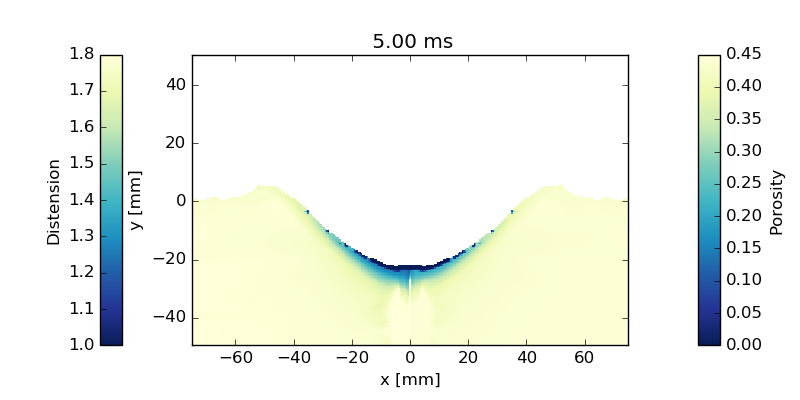Cratering in sand at 500G - isale-code/isale-wiki GitHub Wiki
This numerical model shows a vertical impact into sand under very high gravity (500G). A spherical polyethylene projectile, 13 mm in diameter, impacts at 1.9 km/s into sand, which is represented in the model as 44% porous fused silica. The impact conditions replicate those of impact experiments into sand in a centrifuge by Housen and Holsapple (2003).
Change into the relevant example directory and run the problem in the background. The calculation should take a few hours.
cd /share/examples/Sand2D ./iSALE2D &
This example demonstrates the use of epsilon-alpha porosity model (PORMOD==WUNNEMA), which calculates the compaction of pore space between sand grains. For more details see the manual and: Wunnemann et al. (2006), Collins et al. (2011), Miljkovic et al. (2012).
The epsilon-alpha porosity model (PORMOD==WUNNEMA) is used in conjunction with a simple stiffened-gas equation of state for solid fused silica (parameters from Borg et al., 2005), named in material.inp as fuseqtz.
PORMOD Porosity model : WUNNEMA --------------- Porosity properties -------------
ALPHA0 sets the initial distension, which is related to initial porosity by porosity = 1.-1./alpha = 0.44444
ALPHA0 Initial porosity : 1.80D0
EPSE0 sets the volume strain threshold for elastic compaction. As this is zero, the material will begin compacting with any increase in pressure
EPSE0 Elastic threshold : 0.00D0
ALPHAX sets the distension at which the crush curve switches from exponential to power-law (see Wunnemann et al. (2006) and Collins et al. (2011) for details).
ALPHAX Transition : 1.29D0
KAPPA sets the rate at which compaction occurs with increasing volume strain; 0.97-0.98 is typical for sand, see Wunnemann et al. (2006)
KAPPA Exp coefficient : 0.988D0
CHI is the ratio of the bulk sound speeds of the initial porous material and the non-porous matrix material (fused silica), see Collins et al. (2011).
CHI Sound speed ratio : 0.33D0 -------------------------------------------------
Mesh includes high resolution zone and an extension zones. The cell size is such that the size of the mesh correspond to laboratory scale experiments.
------------------- Mesh Geometry Parameters --------------------------------------- GRIDH horizontal cells : 0 : 150 : 45 GRIDV vertical cells : 60 : 200 : 0 GRIDEXT ext. factor : 1.05d0 GRIDSPC grid spacing : 5.0D-4
To simulate the conditions in the laboratory centrifuge, the (constant) vertical gravity is set to nearly 500 G:
GRAV_V gravity : -4.905D3
Two important parameters in this set up are DTMAX and ANC:
------------------- Time Parameters --------------------------------- DTMAX maximum timestep : 5.0D-8 ------------------- Numerical Stability Parameters ------------------ ANC alt. node coupl. : 0.4D0
In this context, ANC is used to suppress spurious deformation along the symmetry axis by activating the alternate node coupler in cells close to the left boundary.
The magnitude of the coupler anco is proportional to the timestep dt, normalised by the input parameter DTMAX: anco = ANC*dt/DTMAX. Hence, if DTMAX is set to be too large, the alternate node coupler will have no effect. Hence, in this simulation DTMAX has been carefully chosen to be approximate twice the maximum timestep actually used in the calculation (recorded in PROGRESS/timestep.txt0). This is so that the value of anco during most of the simulation is ~0.4/2 = 0.2, and is less if the timestep is smaller.
To produce output images using pySALEPlot:
python Plotting/plot.py
This produces a series of images in the directory Plots/, two of which are shown below. The plots show distension (left) and porosity (right) at 0, 0.5, 2.5 ms and 5 ms after impact. The simulation ends after 5 ms (TEND=5 ms in the example asteroid.inp file); however, the crater in sand is not fully formed at this time--extending the end time is required to simulate crater formation until completion.



